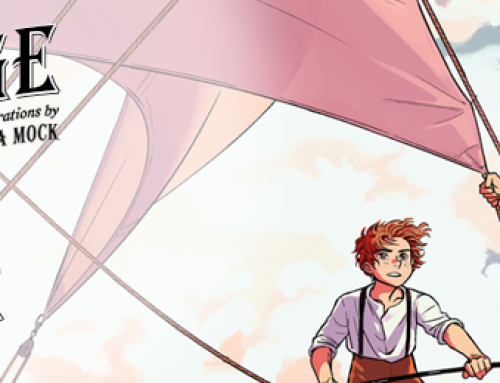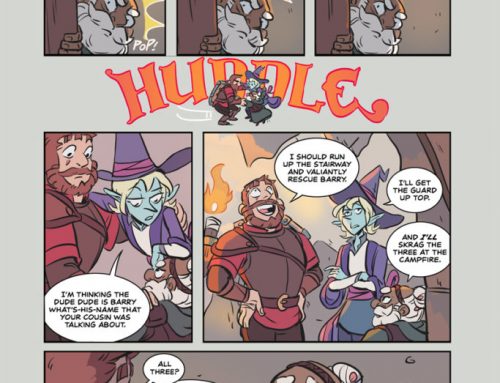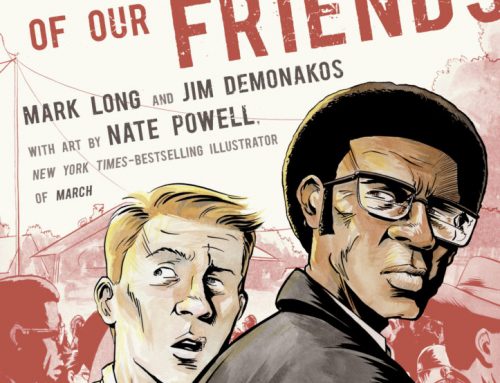test heading
Last month Gene Yang was the keynote speaker at YALSA. The excellent Jennifer Brown at Shelf Awareness has the most complete report on what sounds like a fascinating presentation by the author of American Born Chinese, and the upcoming The Eternal Smile, with Derek Kirk Kim…
YALSA Institute: Gene Luen Yang on How America Reads Graphic Novels
Gene Luen Yang set the tone for the inaugural YALSA Institute, held in Nashville, Tenn., last month, with the probing questions he raised in his keynote speech on Friday, November 7. From his perch in the center of the comics/graphic novel world (his book American Born Chinese was a National Book Award finalist and won the 2007 Printz Award) and also as one who still teaches (computer science) in the classroom, Yang offered a perspective that caught fire, with themes that surfaced in other programs throughout the weekend.
In a series of images (naturally) along with his commentary, Yang suggested that two invasions involving comics are occurring: "Invasion #1: Comics as a MEDIUM is invading America!" He showed a broad variety of images, both two-dimensional (e.g., Spiderman superhero comics and Sendak's In the Night Kitchen) and three-dimensional (such as a relief of the Stations of the Cross and the FDR memorial in Washington, D.C.), and cited several "definitions" of comics by the likes of Will Eisner, Scott McCloud and David Kunzle. Yang then offered his own "Statement About Comics . . . 'Comics is a convergence of pictures and words,'" and demonstrated how "Pictures are Invading Words!" with M.T. Anderson's series that launched with Whales on Stilts!, Brian Selznick's Caldecott-winning The Invention of Hugo Cabret and The Absolutely True Diary of a Part-Time Indian by Sherman Alexie, plus a quotidian example, USA Today. To show how "Words are Invading Pictures," he again pointed to Selznick's Hugo Cabret, but also to CNN. with its breaking news running across the bottom of the screen like a tickertape, and the Colbert Report's "The Word" feature (in this case, highlighting "truthiness").
Yang thus set up the ways in which words and pictures today poach territories that were once exclusive to one or the other. "Words are 'sequential access,'" he posited, showing a page from To Kill a Mockingbirdby Harper Lee, while "Pictures are 'Random Access,'" highlighting George Seurat's painting Sunday Afternoon on the Island of la Grande Jatte as an example. But, he continues, in "Gene's Other Statement About Comics . . . Comics is a convergence of 'sequential access' and 'random access.'" Comics join these two ideas. "In comics, we have . . . Sequential Access Pictures!" in the form of books such as Shaun Tan'sThe Arrival, and "Random Access Words!" with examples such as Phoenix by Osamu Tezuka (featuring an urban scene of several parallel overcrowded escalators with people speaking in unrelated thought balloons). Yang cited everyday instances of the "Convergence of Sequential and Random Access" in Wikipedia and CNN.
"So what's the fall-out of this invasion?" Yang asked. "America is ready for and expects sophisticated interplay between visual and text-based media." He also observed "Invasion #2: Comics as a CULTURE is invading America!" He touched on fan input in comics and in other media, citing American Idol and Dancing with the Stars, how attendees at Comic Con dress like the characters they read about and come to see at the convention (adults dressing as superheroes, yes, but also teens dressed as Harry Potter characters). "So what's the fall-out of this invasion?" he asks. "America expects audience participation." He then takes it a step further and says, "America expects audience ownership!"
"What to Do?! OR: How I Learned to Stop Worrying and Love Comics" appeared next on a slide showing the famous shot of the smiling cowboy doffing his 10-gallon hat as he rides the missile in Dr. Strangelove. Yang's answer was a series of suggestions on how to embrace graphic novels and use comics to inspire reading: The Iron Man comics for those who've seen the movie; the graphic novel ofPrince of Persia for those who've played the video game; pairing his own American Born Chinese withMonkey: A Journey to the West, retold by David Kherdian. He also suggested encouraging students to create their own comics (with Scott McCloud's Understanding Comics, Reinventing Comics and Making Comics; Will Eisner's Comics and Sequential Art, Graphic Storytelling and Visual Narrative andExpressive Anatomy for Comics and Narrative; as well as Drawing Words and Writing Pictures by Jessica Abel and Matt Madden).
Yang offered a strong model set out by the Buffalo and Erie County Public Library's "Get Graphic" program with these suggestions and notes (their Web site, listed below, also contains tips for making them a reality in bookstores, libraries, and classrooms):
- Promote graphic novel of the month
- Offer cartooning classes
- Publish an anthology of comics created by students
- Host author visits
- Create graphic novel classroom kits
Learn more at getgraphic.org.–Jennifer M. Brown




